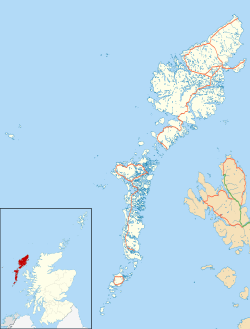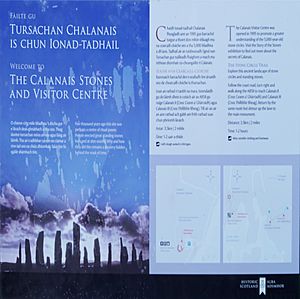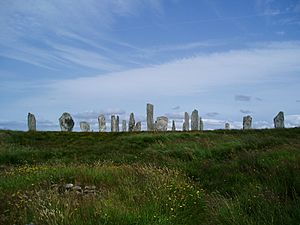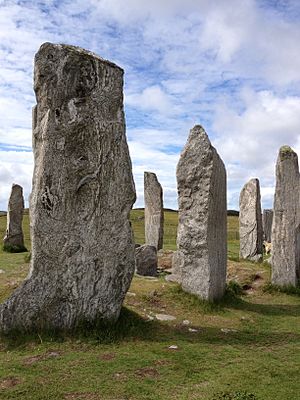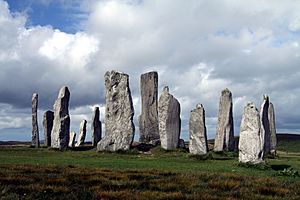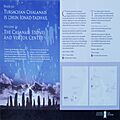Callanish Stones facts for kids
|
Clachan Chalanais
|
|

The stone circle at the centre of the Callanish Stones
|
|
| Alternative name | Callanish I |
|---|---|
| Location | Lewis |
| Coordinates | 58°11′51″N 6°44′43″W / 58.1975410°N 6.7451448°W |
| Type | Stone circle and rows |
| History | |
| Periods | Neolithic, Bronze Age |
The Callanish Stones are an amazing group of standing stones on the Isle of Lewis in Scotland. People also call them "Callanish I." These ancient stones are arranged in a special cross shape, with a circle of stones in the middle. They were first put up a very long time ago, during the late Stone Age. They were an important place for special ceremonies during the Bronze Age. You can find them near the village of Callanish (which is Calanais in Gaelic) on the west coast of the Outer Hebrides.
Contents
Where are the Callanish Stones?
The Callanish Stones sit on a low hill. From here, you can see the waters of Loch Roag and the hills of Great Bernera behind them. It's a beautiful and peaceful spot.
Many other ancient stone sites are close by, just a few kilometers away. You can even see some of them from the main Callanish Stones! These include other stone circles, lines of stones, and single standing stones. The fact that there are so many monuments nearby shows that Callanish was a very important place for religious activities for over 1,500 years in prehistoric times.
Who Looks After the Stones?
The Callanish Stones are looked after by an organization called Historic Environment Scotland. There is also a special visitor center nearby. It's run by Urras Nan Tursachan, which means "The Standing Stones Trust." This center helps people learn all about the stones.
What Do the Callanish Stones Look Like?
The Callanish Stones are made up of a stone circle with thirteen stones. There's also a tall stone right in the middle. Five lines, or "rows," of standing stones connect to this central circle.
Two long rows of stones run almost side-by-side from the stone circle towards the north. These form a kind of "avenue." There are also shorter rows of stones pointing to the west, south, and east. All the stones are made from the same type of rock found in the area, called Lewisian gneiss. Inside the stone circle, to the east of the central stone, there's also an ancient burial chamber.
The Tall Stone in the Middle
The central stone is called a monolith. It stands about 4.8 meters (nearly 16 feet) tall. It's about 1.5 meters (5 feet) wide and 0.3 meters (1 foot) thick. The widest sides of this stone face almost perfectly north and south. This huge stone looks a bit like the steering part of a ship and probably weighs around seven tons!
The Stone Circle
The main stone circle has thirteen stones. It's about 11.4 meters (37 feet) across. It's not a perfect circle, but more of a slightly flattened ring. The stones in the circle are about three meters (10 feet) tall on average. This circle covers an area of 124 square meters. This is quite small compared to some other similar stone circles.
The Northern Avenue
The avenue is a path made of stones that leads from the stone circle towards the north. It's about 83.2 meters (273 feet) long. Today, 19 stones remain in this avenue: nine on the east side and ten on the west side. The tallest stone in the avenue is 3.5 meters (11.5 feet) high. It stands at the northern end of the western row. The two rows of stones in the avenue are not exactly parallel. They spread out a bit, being wider at the north end than at the south end.
Other Stone Rows
Besides the two rows that form the avenue, three other stone rows connect to the central circle. One row comes from the east, one from the south, and one from the west.
- The eastern row has five stones and is 23.2 meters (76 feet) long.
- The southern row also has five stones and is 27.2 meters (89 feet) long.
- The western row has four stones and is 13 meters (43 feet) long.
It's interesting that none of these stone rows point exactly to the very center of the stone circle.
The Ancient Burial Tomb
There is a chambered tomb (an ancient burial place) inside the stone circle. It's about 6.4 meters (21 feet) long. This tomb was built after the stone circle was already standing. It was squeezed in between the central stone and the stones on the eastern side of the circle.
There's also another pile of stones, called a cairn, just northeast of the circle. It's mostly flat now, so you can barely see its shape. We don't know for sure if it was part of the original monument.
How Old Are the Callanish Stones?
Archaeologists (people who study ancient times) did some digging in 1980 and 1981. They found out more about how the site developed over time. The very first signs of people living here show a wide ditch. This ditch might have been part of an early building or enclosure.
Around 3000 BC, the area was used for farming. This farming covered up most of the older traces. After that, the land was left to grow grass for a while.
The stone circle itself was put up between 2900 and 2600 BC. It's not clear if the lines of stones were built at the same time as the circle, or a bit later. Some time after the stones were standing, the small burial tomb was added inside the eastern part of the stone circle. Many broken pieces of pottery were found in the tomb. This tells us that the tomb was used for several centuries for burials. These pottery pieces included local pots and also special pots from the Beaker culture.
Around 1500 to 1000 BC, people stopped using the stone complex for its original purpose. Farmers from the later Bronze Age might have disturbed the site. It seems that the place was abandoned around 800 BC. The stones were covered by a thick layer of peat (a type of soil) for a long time. It wasn't until 1857 that this peat, which was about 1.5 meters (5 feet) deep, was finally removed. This revealed the true height of the stones and the burial tomb.
The Stones Through History
The first time someone wrote about the Callanish Stones was around 1680. A local man named John Morisone wrote that the stones were people who had been "turned into stone by an enchanter." He said they were set up in a circle "for devotion."
Later, around 1695, a man named Martin Martin visited the site. Local people told him it was a place for worship in "heathen" times. They said the main priest stood near the big stone in the center and spoke to the people around him.
Over the years, many people have been fascinated by the stones. In 1857, the deep layer of peat covering the stones was finally cleared away. This was ordered by James Matheson, who owned the land. This work showed everyone the burial tomb and how tall the stones really were. In 1885, the Callanish Stones were officially taken into the care of the state to protect them.
Stories and Legends
There are many old stories about the Callanish Stones. One legend says they were once giants who refused to become Christians. So, they were turned into stone! In the 1600s, people on Lewis called the stones fir bhrèige, which means "false men."
Another legend says that on early midsummer mornings, a special being called the "Shining One" walks along the avenue of stones. People say you can hear the call of a cuckoo bird just before he appears.
The Callanish Stones in Pop Culture
The Callanish Stones have inspired many artists, musicians, and writers:
- In 1974, a sculptor named Gerald Laing created a work called Callanish. He placed 16 abstract steel beams in the ground to look like the stone arrangement. People often call it "Steelhenge."
- The stones are a setting in the 1974 novel Lookout Cartridge by Joseph McElroy.
- The band Ultravox used an image of the stones on the cover of their 1984 album Lament. They even filmed parts of their music video for the song "One Small Day" at the site.
- Julian Cope's 1992 album Jehovahkill features the stones on its cover.
- The 2012 Pixar film Brave has several scenes that take place around stones that look very much like the Callanish Stones.
- Bank of Scotland debit cards feature an image of the stones, along with other famous Scottish landmarks.
- The TV show Outlander (which is based on a book series) uses the Callanish Stones as a model for a fictional stone circle called Craigh na Dun. In the show, these stones allow people to travel through time when touched!
Other Stone Sites Nearby
Archaeologists often call the main monument "Callanish I." This is because there are many other ancient stone sites very close by. These include other stone circles, standing stones, and even ancient settlements. Some of these are:
- "Cnoc Ceann a' Ghàraidh" (Callanish II) – another stone circle
- "Cnoc Filibhir Bheag" (Callanish III) – another stone circle
- "Tursachan" (Callanish VIII) – a unique half-circle monument on a nearby island
- "Na Dromannan" (Callanish X)
There are many more sites in the area, though not all of them are still visible today. For example, there was once a timber (wood) circle about 0.5 km south near Loch Roag.
Images for kids
See also
 In Spanish: Piedras de Callanish para niños
In Spanish: Piedras de Callanish para niños


